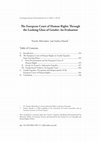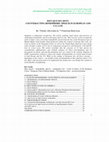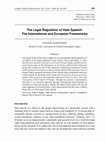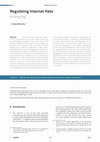Papers by Natalie Alkiviadou
The International Journal of Human Rights

Gottingen Journal of International Law, 2021
Gender equality is of paramount importance for a functioning democracy and
for economic growth. I... more Gender equality is of paramount importance for a functioning democracy and
for economic growth. It is a central tenet of human rights law and has seen
significant developments on the legislative, judicial, and policy levels of the
Council of Europe. Through a mélange of theory, legislation, and jurisprudential
analysis, this paper will assess developments in the European Court of Human
Rights’ approach to the issue of gender equality. This will be achieved through a
survey of case law involving domestic violence, child-bearing, and the wearing of
religious dress by women. The paper will demonstrate that, despite the existence
of significant milestones in the ambit of promoting gender equality, and,
notwithstanding effective advancements made by this body, particularly vis-àvis domestic violence case law, improvements to its approach remain necessary.
More specifically, on one level, the Court denounces and works against gender
inequality and discrimination but, on another, consciously or unconsciously, its
approach and findings are marred by its own stereotypes, patriarchal influences,
misconceptions, and preconceptions about what gender equality actually is and
how it should be pursued.
European-Asian Journal of Law and Governance (vol.10), 2021

Human Rights Law Review, 2021
In Handyside v. The United Kingdom, the European Court of Human Rights (ECHR) held that the right... more In Handyside v. The United Kingdom, the European Court of Human Rights (ECHR) held that the right to freedom of expression, as provided for in Article 10 of the European Convention on Human Rights protects not only expressions that are favorably received but also those that ‘offend, shock or disturb’. 1 Yet, the Court has since developed a substantial body of inconsistent case-law allowing restrictions on ‘hate speech’ that severely questions the degree to which offensive, shocking and disturbing speech is truly protected by the ECHR. Against a qualitative and quantitative backdrop, the authors argue that the Court and previously the Commission, have adopted an overly restrictive approach to hate speech, which fails to provide adequate protection to political speech on controversial issues, including criticism of public officials and government institutions and has created an inconsistent and even arbitrary body of case law. Instead, jurisdictions that recognize a need to balance the freedom of expression with limits on hate speech have adopted more convincing approaches of hate speech, providing a robust protection of free speech while leaving room for the State to curtail the most extreme forms of non-violent hate speech.

International Journal of Discrimination and the Law (vol 21 (4), pp. 374-400), 2021
Adopting a comparative perspective, this article examines legal means and practices of challengin... more Adopting a comparative perspective, this article examines legal means and practices of challenging homophobic speech in European and U.S. law. This exercise revolves around the study of major cases concerning homophobic speech from the law of the European Court of Human Rights (and broader legal framework within the Council of Europe (the CoE), the Court of Justice of the European Union, as well as the United States Supreme Court (along with a broader scrutiny of U.S. law in comparative perspective with European CoE and EU law) in recent years. The article concludes that the concepts of (1) hate speech (in constitutional, administrative and criminal settings) (2) direct discrimination and (3) harassment (in labour and anti-discrimination law) are central in the strategic litigation of LGBT organizations seeking to redress the climate of homophobia via various legal avenues in both Europe and the U.S. While in the settings of European law, all three concepts – depending on the context – can benefit victims of homophobia in their judicial redress, U.S. law offers coherent protection in its employment law framework, even though this remains in need of further strengthening.

European Journal of Law Reform, 2018
In 2008, the European Union was hit by the most severe financial downturn since the Great Recessi... more In 2008, the European Union was hit by the most severe financial downturn since the Great Recession of the 1930s. One of the major consequences of this phenomenon was the deterioration in the enjoyment of human rights, in particular economic and social rights. While it is indisputable that the crisis itself was directly correlated to the erosion of such rights, the conditions attached to the loan agreements between defaulting countries and the three lending institutions, namely the International Monetary Fund (IMF), the European Central Bank and the European Commission, have negatively affected the rights under consideration. Loans came with strict austerity measures, such as public expenditure cuts in the realm of, inter alia, public services, benefits and social security. This article considers the deterioration in the enjoyment of economic and social rights by Union inhabitants and particularly the anti-crisis strategy adopted by the European Union, which, as will
be demonstrated, directly contributed to this deterioration. The stance of the three institutions was facilitated by the less than proactive, but improving, positioning of the Court of Justice of the European Union in case law, which will be assessed. It must be noted that it is not the three institutions acting alone in this process; the Member States are the ones who agree to the loans and their conditions and implement austerity measures on the ground. However, as will be reflected, the practical
role and actual input of the countries themselves in this procedure is limited. The central theoretical tenet of the article is that the European Union is re-shifting its direction to the almost absolute adoption of an economic constitution, with little regard to its social counterpart. Within the aforementioned framework, this article seeks to assess the status of economic and social rights in a crisis-hit Union, provide a theoretical explanation for this occurrence and put forth possibilities for positive
change, placing the protection and promotion of economic and social rights at the heart of any responses to crisis as a method to ensure their sustainable protection effectively.

Croatian Political Science Review, Vol. 55 No. 4, 2018, 2018
This paper looks at the tools available on an international and European level in relation to the... more This paper looks at the tools available on an international and European level in relation to the legal regulation of hate speech. More particularly, it considers the International Covenant on Civil and Political Rights and the International Convention on the Elimination of All Forms of Racial Discrimination along with related case-law of the respective monitoring committees. It looks at the European Convention on Human Rights and how the European Court of Human Rights interprets the limits of free speech when confronted with cases of hate speech. It also looks at the Framework Decision on Racism and Xenophobia of the European Union and the Additional Protocol to the Cybercrime Convention of the Council of Europe. Through the analysis it demonstrates that there is no common approach amongst international and European institutions on what hate speech is and the threshold which needs to be met for legal regulation to be permissible. It also demonstrates that the tools available focus only on some types of hate speech.

Hate speech and hate crime are an anathema to any society. On a United Nations level, the central... more Hate speech and hate crime are an anathema to any society. On a United Nations level, the central tools to tackle such hatred are Article 20(2) of the International Covenant on Civil and Political Rights and Article 4 of the International Convention on the Elimination of All Forms of Racial Discrimination. On a Council of Europe level, the Additional Protocol to the Cybercrime Convention tackles racist and xenophobic material, threats and insults as well as revisionist rhetoric transmitted and disseminated through computer systems. On a European Union level, there is the Framework Decision on Racism and Xenophobia. In none of the above-mentioned instruments do we find provisions on homophobic and transphobic speech and crime, nor are there equivalents of documents such as the Framework Decision with the thematic of homophobia and transphobia. This creates a hierarchy of hate, with some forms of hate considered more important than others by the aforementioned institutions, a reality that goes against the very essence of international human rights law.
Social networks serve as effective platforms in which users’ ideas can be spread in an easy and e... more Social networks serve as effective platforms in which users’ ideas can be spread in an easy and efficient manner. However, those ideas can be hateful and harmful, some of which may even amount to hate speech. YouTube, Facebook and Twitter have internal regulatory policies in relation to hate speech and have signed a Code of Conduct on the regulation of illegal hate speech with the European Commission. This paper looks at the issue of tackling hate speech on social networks and argues that, notwithstanding the weaknesses of internal policies and their implementation, their existence, as facilitated by the Code of Conduct, serves as a light at the end of the Internet hate tunnel where issues of multiple jurisdictions as well as technological realities, such as mirror sites and more, have resulted in the task of online regulation being more than a daunting one.
A perusal on how the ECtHR treats religious freedom with a focus on the manifestation of Christia... more A perusal on how the ECtHR treats religious freedom with a focus on the manifestation of Christianity and Islam through religious symbols and dress and a short comparison on how the CJEU has looked at the treatment of the hijab in the worplace
A paper on the Code of Conduct signed between the European Commission and IT companies, the hiera... more A paper on the Code of Conduct signed between the European Commission and IT companies, the hierarchy of hate and the discrepancies in thresholds and penalties of hate speech on an international and European level.

Journal of Intellectual Property, Information Technology and E-Commerce Law, 2016
This paper will assess the regulation of the internet in the ambit of hate speech expressed digit... more This paper will assess the regulation of the internet in the ambit of hate speech expressed digitally through the internet. To do so, it will provide a definitional framework of hate speech, an overview of the internet’s role in the ambit of hate speech and consider the challenges in legally regulating online hate speech through a discussion of relevant case-law as well as the Additional Protocol to the Cybercrime Convention. The jurisprudential analysis will allow for a comparison of the stances adopted by the ECtHR and national courts of European countries on the one hand, and courts of the United States on the other, in the sphere under consideration. By looking at regional and national case-law and the initiative of the Council of Europe in the form of the Additional Protocol to the Cybercrime Convention, the paper seeks to provide an overview of the current state of affairs in the realm of regulating hate but also to demonstrate that such regulation, as occurring to date, is dysfunctional, predominantly due to the vast divergence of US-European approaches to the issues of free expression both on and off line. It is argued that due to the very nature of the internet as a borderless and global entity, this normative divergence cannot be overcome so long as traditional approaches to the issue of regulation continue to be taken. The paper’s analysis will emanate from the premise that there exists a need to strike an equitable balance between the freedom of expression on the one hand and the freedom from discrimination on the other.
International Journal of Discrimination and the Law , 2017
Greece transposed the 2000 equality directives through Law 3304/2005. This law sets out the defin... more Greece transposed the 2000 equality directives through Law 3304/2005. This law sets out the definitions of direct and indirect discrimination, designates what conduct should be prohibited, outlines the sanctions that are to be imposed by the judiciary and mandates three equality bodies with the duty of upholding and promoting equal treatment. This article argues that notwithstanding the theoretical significance of this law given that it was the first tool specifically designed to grant legislative protection for the principle of equal treatment, its practical effects are limited.
Books by Natalie Alkiviadou
Springer Briefs in Linguistics, 2017
My chapter in 'Online Hate Speech in the European Union - A Discourse Analytic Perspective' edite... more My chapter in 'Online Hate Speech in the European Union - A Discourse Analytic Perspective' edited by Assimakopoulos, Baider and Millar, Springer Briefs in Linguistics (2017)
Book Reviews by Natalie Alkiviadou











Uploads
Papers by Natalie Alkiviadou
for economic growth. It is a central tenet of human rights law and has seen
significant developments on the legislative, judicial, and policy levels of the
Council of Europe. Through a mélange of theory, legislation, and jurisprudential
analysis, this paper will assess developments in the European Court of Human
Rights’ approach to the issue of gender equality. This will be achieved through a
survey of case law involving domestic violence, child-bearing, and the wearing of
religious dress by women. The paper will demonstrate that, despite the existence
of significant milestones in the ambit of promoting gender equality, and,
notwithstanding effective advancements made by this body, particularly vis-àvis domestic violence case law, improvements to its approach remain necessary.
More specifically, on one level, the Court denounces and works against gender
inequality and discrimination but, on another, consciously or unconsciously, its
approach and findings are marred by its own stereotypes, patriarchal influences,
misconceptions, and preconceptions about what gender equality actually is and
how it should be pursued.
be demonstrated, directly contributed to this deterioration. The stance of the three institutions was facilitated by the less than proactive, but improving, positioning of the Court of Justice of the European Union in case law, which will be assessed. It must be noted that it is not the three institutions acting alone in this process; the Member States are the ones who agree to the loans and their conditions and implement austerity measures on the ground. However, as will be reflected, the practical
role and actual input of the countries themselves in this procedure is limited. The central theoretical tenet of the article is that the European Union is re-shifting its direction to the almost absolute adoption of an economic constitution, with little regard to its social counterpart. Within the aforementioned framework, this article seeks to assess the status of economic and social rights in a crisis-hit Union, provide a theoretical explanation for this occurrence and put forth possibilities for positive
change, placing the protection and promotion of economic and social rights at the heart of any responses to crisis as a method to ensure their sustainable protection effectively.
Books by Natalie Alkiviadou
Book Reviews by Natalie Alkiviadou
for economic growth. It is a central tenet of human rights law and has seen
significant developments on the legislative, judicial, and policy levels of the
Council of Europe. Through a mélange of theory, legislation, and jurisprudential
analysis, this paper will assess developments in the European Court of Human
Rights’ approach to the issue of gender equality. This will be achieved through a
survey of case law involving domestic violence, child-bearing, and the wearing of
religious dress by women. The paper will demonstrate that, despite the existence
of significant milestones in the ambit of promoting gender equality, and,
notwithstanding effective advancements made by this body, particularly vis-àvis domestic violence case law, improvements to its approach remain necessary.
More specifically, on one level, the Court denounces and works against gender
inequality and discrimination but, on another, consciously or unconsciously, its
approach and findings are marred by its own stereotypes, patriarchal influences,
misconceptions, and preconceptions about what gender equality actually is and
how it should be pursued.
be demonstrated, directly contributed to this deterioration. The stance of the three institutions was facilitated by the less than proactive, but improving, positioning of the Court of Justice of the European Union in case law, which will be assessed. It must be noted that it is not the three institutions acting alone in this process; the Member States are the ones who agree to the loans and their conditions and implement austerity measures on the ground. However, as will be reflected, the practical
role and actual input of the countries themselves in this procedure is limited. The central theoretical tenet of the article is that the European Union is re-shifting its direction to the almost absolute adoption of an economic constitution, with little regard to its social counterpart. Within the aforementioned framework, this article seeks to assess the status of economic and social rights in a crisis-hit Union, provide a theoretical explanation for this occurrence and put forth possibilities for positive
change, placing the protection and promotion of economic and social rights at the heart of any responses to crisis as a method to ensure their sustainable protection effectively.